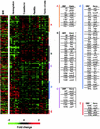Transcriptional response of Pasteurella multocida to defined iron sources
- PMID: 12426360
- PMCID: PMC135407
- DOI: 10.1128/JB.184.23.6714-6720.2002
Transcriptional response of Pasteurella multocida to defined iron sources
Abstract
Pasteurella multocida was grown in iron-free chemically defined medium supplemented with hemoglobin, transferrin, ferritin, and ferric citrate as iron sources. Whole-genome DNA microarrays were used to monitor global gene expression over seven time points after the addition of the defined iron source to the medium. This resulted in a set of data containing over 338,000 gene expression observations. On average, 12% of P. multocida genes were differentially expressed under any single condition. A majority of these genes encoded P. multocida proteins that were involved in either transport and binding or were annotated as hypothetical proteins. Several trends are evident when the data from different iron sources are compared. In general, only two genes (ptsN and sapD) were expressed at elevated levels under all of the conditions tested. The results also show that genes with increased expression in the presence of hemoglobin did not respond to transferrin or ferritin as an iron source. Correspondingly, genes with increased expression in the transferrin and ferritin experiments were expressed at reduced levels when hemoglobin was supplied as the sole iron source. Finally, the data show that genes that were most responsive to the presence of ferric citrate did not follow a trend similar to that of the other iron sources, suggesting that different pathways respond to inorganic or organic sources of iron in P. multocida. Taken together, our results demonstrate that unique subsets of P. multocida genes are expressed in response to different iron sources and that many of these genes have yet to be functionally characterized.
Figures



Similar articles
-
Pasteurella multocida gene expression in response to iron limitation.Infect Immun. 2001 Jun;69(6):4109-15. doi: 10.1128/IAI.69.6.4109-4115.2001. Infect Immun. 2001. PMID: 11349083 Free PMC article.
-
Genomic scale analysis of Pasteurella multocida gene expression during growth within the natural chicken host.Infect Immun. 2002 Dec;70(12):6871-9. doi: 10.1128/IAI.70.12.6871-6879.2002. Infect Immun. 2002. PMID: 12438364 Free PMC article.
-
Transcriptional response of Pasteurella multocida to nutrient limitation.J Bacteriol. 2002 Jul;184(13):3734-9. doi: 10.1128/JB.184.13.3734-3739.2002. J Bacteriol. 2002. PMID: 12057970 Free PMC article.
-
How does Pasteurella multocida respond to the host environment?Curr Opin Microbiol. 2006 Feb;9(1):117-22. doi: 10.1016/j.mib.2005.12.005. Epub 2006 Jan 6. Curr Opin Microbiol. 2006. PMID: 16406771 Review.
-
Study in the iron uptake mechanism of Pasteurella multocida.Vet Res. 2025 Feb 13;56(1):41. doi: 10.1186/s13567-025-01469-0. Vet Res. 2025. PMID: 39948631 Free PMC article. Review.
Cited by
-
The transcriptional response of Pasteurella multocida to three classes of antibiotics.BMC Genomics. 2009 Jul 14;10 Suppl 2(Suppl 2):S4. doi: 10.1186/1471-2164-10-S2-S4. BMC Genomics. 2009. PMID: 19607655 Free PMC article.
-
Genome-wide expression profiling in Geobacter sulfurreducens: identification of Fur and RpoS transcription regulatory sites in a relGsu mutant.Funct Integr Genomics. 2007 Jul;7(3):229-55. doi: 10.1007/s10142-007-0048-5. Epub 2007 Apr 4. Funct Integr Genomics. 2007. PMID: 17406915
-
The phosphotransferase system formed by PtsP, PtsO, and PtsN proteins controls production of polyhydroxyalkanoates in Pseudomonas putida.J Bacteriol. 2007 Jun;189(12):4529-33. doi: 10.1128/JB.00033-07. Epub 2007 Apr 6. J Bacteriol. 2007. PMID: 17416664 Free PMC article.
-
Identification of the Avian Pasteurella multocida phoP Gene and Evaluation of the Effects of phoP Deletion on Virulence and Immunogenicity.Int J Mol Sci. 2015 Dec 23;17(1):12. doi: 10.3390/ijms17010012. Int J Mol Sci. 2015. PMID: 26703595 Free PMC article.
-
Host iron binding proteins acting as niche indicators for Neisseria meningitidis.PLoS One. 2009;4(4):e5198. doi: 10.1371/journal.pone.0005198. Epub 2009 Apr 8. PLoS One. 2009. PMID: 19352437 Free PMC article.
References
-
- Andrews, S. C. 1998. Iron storage in bacteria. Adv. Microb. Physiol. 40:281-351. - PubMed
-
- Braun, V., and H. Killmann. 1999. Bacterial solutions to the iron-supply problem. Trends Biochem. Sci. 24:104-109. - PubMed
-
- Bullen, J. J. 1981. The significance of iron in infection. Rev. Infect. Dis. 3:1127-1138. - PubMed
-
- Bullen, J. J., H. J. Rogers, and E. Griffiths. 1978. Role of iron in bacterial infection. Curr. Top. Microbiol. Immunol. 80:1-35. - PubMed
-
- Burns, C. M., L. V. Richardson, and J. P. Richardson. 1998. Combinatorial effects of NusA and NusG on transcription elongation and Rho-dependent termination in Escherichia coli. J. Mol. Biol. 278:307-316. - PubMed
Publication types
MeSH terms
Substances
Grants and funding
LinkOut - more resources
Full Text Sources
Medical

